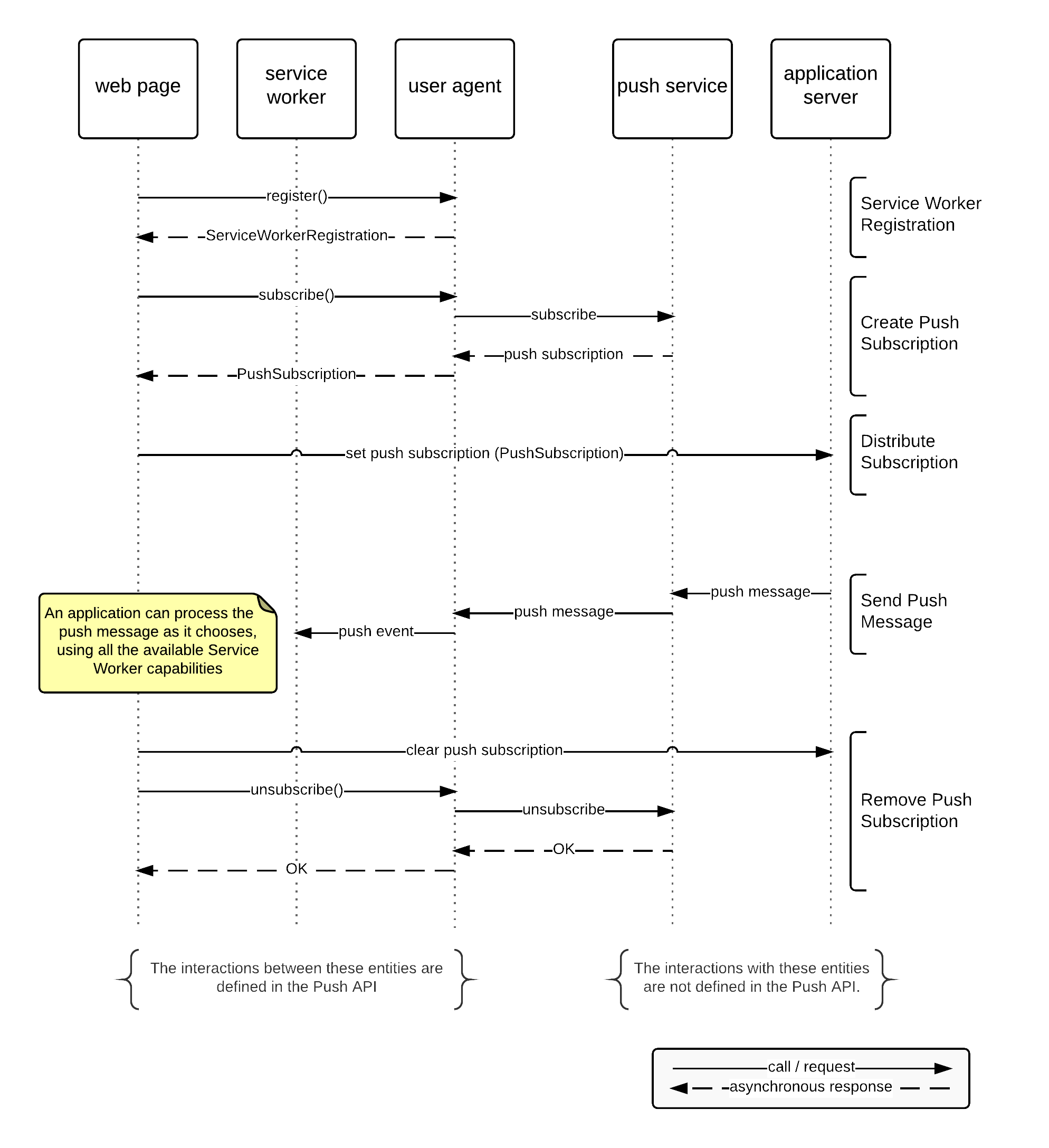目录
摘要 本文档状态 1.
简介
2.
依赖关系
3.
概念
3.1
应用服务器
3.2
推送消息
3.3
声明式推送消息
3.3.1
成员
3.3.2
解析器
3.4
推送订阅
3.4.1
与 Service Worker 注册的关系
3.4.2
订阅刷新
3.4.3
订阅停用
3.5
推送服务
3.6
权限
4.
安全与隐私注意事项
5.
推送框架
5.1
示例
5.2
序列图
5.3
推送服务使用
6.
PushManagerAttribute 混入
7.
PushManager
7.1
subscribe() 方法
7.2
PushSubscriptionOptions7.3
PushSubscriptionOptionsInit
8.
PushSubscription
8.1
PushEncryptionKeyName
9.
PushMessageData10.
事件
10.1
ServiceWorkerGlobalScope 接口的扩展
10.2
PushEvent10.3
接收 推送消息
10.4
pushsubscriptionchange 事件
10.4.1
PushSubscriptionChangeEvent10.4.2
PushSubscriptionChangeEventInit
11.
可访问性
12. 一致性A. IDL 索引B.
致谢
C. 参考文献
C.1
规范性引用C.2
参考性引用
Web 推送协议
[RFC8030 用户代理
或 应用服务器 能够与 推送服务 通信。可以使用其他协议替代本协议,但本规范假定采用该协议;其他协议应提供兼容语义。
Content-Encoding RFC9110 推送消息
负载的内容编码类型。
声明式推送消息 是一个推送消息 ,其数据为用户代理能够理解的 JSON 文档。用户代理会机会性地解析每个收到的
推送消息 ,以判断其是否为声明式推送消息 ,解析过程使用
声明式推送消息解析器 。
声明式推送消息 允许创建和显示通知,无需 Service Worker 的参与。当然,如果
应用服务器 需要,Service Worker 仍可以参与。在这种情况下,推送消息 的声明式属性可作为备用,例如 Service Worker
因存储压力被驱逐时。同时,这种方式为通知数据的传递提供了更面向对象的方案。
{
"web_push" : 8030 ,
"notification" : {
"title" : "Ada emailed ‘London’" ,
"lang" : "en-US" ,
"dir" : "ltr" ,
"body" : "Did you hear about the tube strikes?" ,
"navigate" : "https://email.example/message/12"
}
}
声明式推送消息 包含以下成员:
web_push(必填)
一个整数,值必须为 8030。用于将声明式推送消息
与其它 JSON 文档区分开。
notification(必填)
一个 JSON 对象,包含如下成员,均类似于 Notifications API 的特性,但类型有时更严格。除 title 外,所有成员均来自 NotificationOptionsNOTIFICATIONS
title(必填)
字符串。
dir
"auto"、"ltr" 或 "rtl"。
lang
表示语言标签的字符串。
body
字符串。
navigate(必填)
表示 URL 的字符串。
tag
字符串。
image
表示 URL 的字符串。
icon
表示 URL 的字符串。
badge
表示 URL 的字符串。
vibrate
32 位无符号整数 数组。
timestamp
64 位无符号整数 。
renotify
布尔值。
silent
布尔值。
requireInteraction
布尔值。
data
任意 JSON 值。
actions
JSON 对象数组,包含如下成员,均来自 NotificationAction
action(必填)
字符串。
title(必填)
字符串。
navigate(必填)
表示 URL 的字符串。
icon
表示 URL 的字符串。
mutable
布尔值。当为 true 时,会向(如有)Service Worker 分发包含该Notificationpush 事件,该对象由
声明式推送消息 描述。
声明式推送消息解析器结果 是一个元组 ,包含
notification (一个
notification )和
mutable (一个布尔值)。
声明式推送消息解析器 给定一个字节序列
bytes 、origin
origin 、URL
baseURL ,以及
EpochTimeStampfallbackTimestamp ,执行如下步骤。它们返回失败或声明式推送消息解析器结果 。
令 message 为 解析 JSON 字节为
Infra 值 的结果,参数为 bytes 。若抛出异常,则返回失败。
若 message 不是有序映射 ,则返回失败。
若 message ["web_push"] 不存在 或不是 8030,则返回失败。
若 message ["notification"] 不存在 ,则返回失败。
令 notificationInput = message ["notification"]。
若 notificationInput 不是有序映射 ,则返回失败。
若 notificationInput ["title"] 不存在 或不是字符串,则返回失败。
若 notificationInput ["navigate"] 不存在 或不是字符串,则返回失败。
令 notificationTitle = notificationInput ["title"]。
令 notificationOptions 为 NotificationOptions
若 notificationInput ["dir"]存在 且值为"auto"、"ltr"或"rtl",则设置
notificationOptions ["dirnotificationInput ["dir"]。
若 notificationInput ["lang"]存在 且为字符串,则设置
notificationOptions ["langnotificationInput ["lang"]。
若 notificationInput ["body"]存在 且为字符串,则设置
notificationOptions ["bodynotificationInput ["body"]。
设置 notificationOptions ["navigatenotificationInput ["navigate"],并转换 。
若 notificationInput ["tag"]存在 且为字符串,则设置
notificationOptions ["tagnotificationInput ["tag"]。
若 notificationInput ["image"]存在 且为字符串,则设置
notificationOptions ["imagenotificationInput ["image"],并转换 。
若 notificationInput ["icon"]存在 且为字符串,则设置
notificationOptions ["iconnotificationInput ["icon"],并转换 。
若 notificationInput ["badge"]存在 且为字符串,则设置
notificationOptions ["badgenotificationInput ["badge"],并转换 。
若 notificationInput ["vibrate"]存在 且为列表 ,且每个项
都是32
位无符号整数 ,则设置
notificationOptions ["vibratenotificationInput ["vibrate"]。
若 notificationInput ["timestamp"]存在 且为64 位无符号整数 ,则设置
notificationOptions ["timestampnotificationInput ["timestamp"]。
若 notificationInput ["renotify"]存在 且为布尔值,则
设置 notificationOptions ["renotifynotificationInput ["renotify"]。
若 notificationInput ["silent"]存在 且为布尔值,则
设置 notificationOptions ["silentnotificationInput ["silent"]。
若 notificationInput ["requireInteraction"]存在 且为布尔值,则设置
notificationOptions ["requireInteractionnotificationInput ["requireInteraction"]。
若 notificationInput ["data"]存在 ,则设置
notificationOptions ["data将
Infra 值转换为 JSON 兼容的 JavaScript 值 的结果,参数为
notificationInput ["data"]。
若 notificationInput ["actions"]存在 且为列表 :
令 notificationActions = « »。
对每个
actionInput 属于
notificationInput ["actions"]:
若 actionInput ["action"] 不存在 或不是字符串,则跳过 。
若 actionInput ["title"] 不存在 或不是字符串,则跳过 。
若 actionInput ["navigate"] 不存在 或不是字符串,则跳过 。
令 actionNavigate =
actionInput ["navigate"],
转换 。
令 notificationAction 为 NotificationActionactionactionInput ["action"],
"titleactionInput ["title"],
"navigateactionNavigate ]»。
若 actionInput ["icon"]存在 且为字符串,则
设置 notificationAction ["iconactionInput ["icon"],并转换 。
追加
notificationAction 到
notificationActions 。
设置 notificationOptions ["actionsnotificationActions 。
令 notification 为运行 创建通知 ,参数为
notificationTitle 、notificationOptions 、origin 、
baseURL 和 fallbackTimestamp 的结果。若抛出异常,则返回失败。
若 notification 的导航 URL 为
null,则返回失败。
若 notification 的actions 中任一导航
URL 为 null,则返回失败。
令 mutable = false。
若 message ["mutable"]存在 且
message ["mutable"] 为布尔值,则设置 mutable 为
message ["mutable"]。
返回 (notification , mutable )。
推送 API 本身不提供任何方式来展示从 推送服务 接收到的数据。相反,推送 API 依赖其他 API——主要是
通知 API
标准 推送 API 本身没有可访问性要求。不过,[NOTIFICATIONS
此外,呈现一个无障碍界面可能需要传递比推送消息所能承载的更多信息。推送消息更适合携带少量内容或标识符。如需传递较大的资源,则需要从服务器获取。
dictionary PushPermissionDescriptorPermissionDescriptor
boolean userVisibleOnly
[SecureContext PushManagerAttribute
readonly attribute PushManager pushManager
};
Window includes PushManagerAttribute
ServiceWorkerRegistration includes PushManagerAttribute
[Exposed =(Window,Worker)SecureContext PushManager
[SameObject FrozenArray <DOMString > supportedContentEncodings
Promise <PushSubscription subscribe PushSubscriptionOptionsInit options = {});
Promise <PushSubscription getSubscription
Promise <PermissionState > permissionState PushSubscriptionOptionsInit options = {});
[Exposed =(Window,Worker)SecureContext PushSubscriptionOptions
readonly attribute boolean userVisibleOnly
[SameObject ArrayBuffer ? applicationServerKey
};
dictionary PushSubscriptionOptionsInit
boolean userVisibleOnly
(BufferSource or DOMString )? applicationServerKey
[Exposed =(Window,Worker)SecureContext PushSubscription
readonly attribute USVString endpoint
readonly attribute EpochTimeStamp ? expirationTime
[SameObject PushSubscriptionOptions options
ArrayBuffer ? getKeyPushEncryptionKeyNamename );
Promise <boolean > unsubscribe
PushSubscriptionJSON toJSON
dictionary PushSubscriptionJSON
USVString endpoint
EpochTimeStamp ? expirationTime
record <DOMString , USVString > keys
enum PushEncryptionKeyName"p256dh ,
"auth
};
[Exposed =ServiceWorkerSecureContext PushMessageData
ArrayBuffer arrayBuffer
Blob blob
Uint8Array bytes
any json
USVString text
[Exposed =ServiceWorkerSecureContext ServiceWorkerGlobalScope {
attribute EventHandler onpush
attribute EventHandler onpushsubscriptionchange
};
[Exposed =ServiceWorkerSecureContext PushEventExtendableEvent
constructorDOMString type , optional PushEventInit eventInitDict = {});
readonly attribute PushMessageData data
readonly attribute Notification ? notification
};
dictionary PushEventInitExtendableEventInit
PushMessageDataInit data
Notification ? notification
typedef (BufferSource or USVString ) PushMessageDataInit
[Exposed =ServiceWorkerSecureContext PushSubscriptionChangeEventExtendableEvent
constructorDOMString type , optional PushSubscriptionChangeEventInit eventInitDict = {});
readonly attribute PushSubscription newSubscription
readonly attribute PushSubscription oldSubscription
};
dictionary PushSubscriptionChangeEventInitExtendableEventInit
PushSubscription newSubscription
PushSubscription oldSubscription
编辑们感谢 Mozilla 和 Telefónica Digital 团队实现 Firefox OS 推送消息解决方案,同时感谢下列在本文件中提供重要技术意见的人员:Antonio Amaya、Miguel
García Arribas、Ben Bangert、Kit Cambridge、José Manuel Cantera、JR Conlin、Albert Crespell、Matt Gaunt、Phil
Jenvey、Guillermo López、Nikhil Marathe、John Mellor、Pınar Özlen、Fernando R. Sela、Shijun Sun 和 Doug Turner。
↑
Referenced in:
Not referenced in this document.
Referenced in:
Not referenced in this document.
Referenced in:
Not referenced in this document.
Referenced in:
Not referenced in this document.
Referenced in:
Not referenced in this document.
Referenced in:
Not referenced in this document.
Referenced in:
Not referenced in this document.
Referenced in:
Not referenced in this document.
